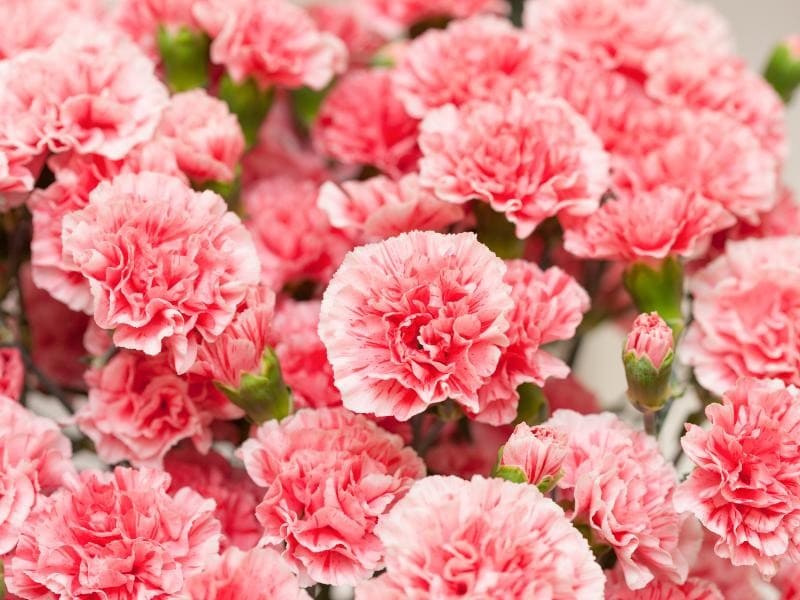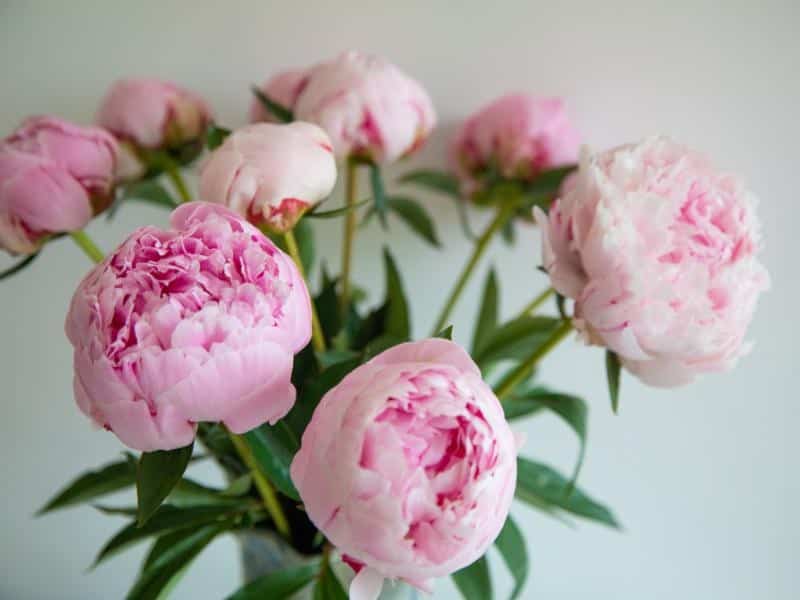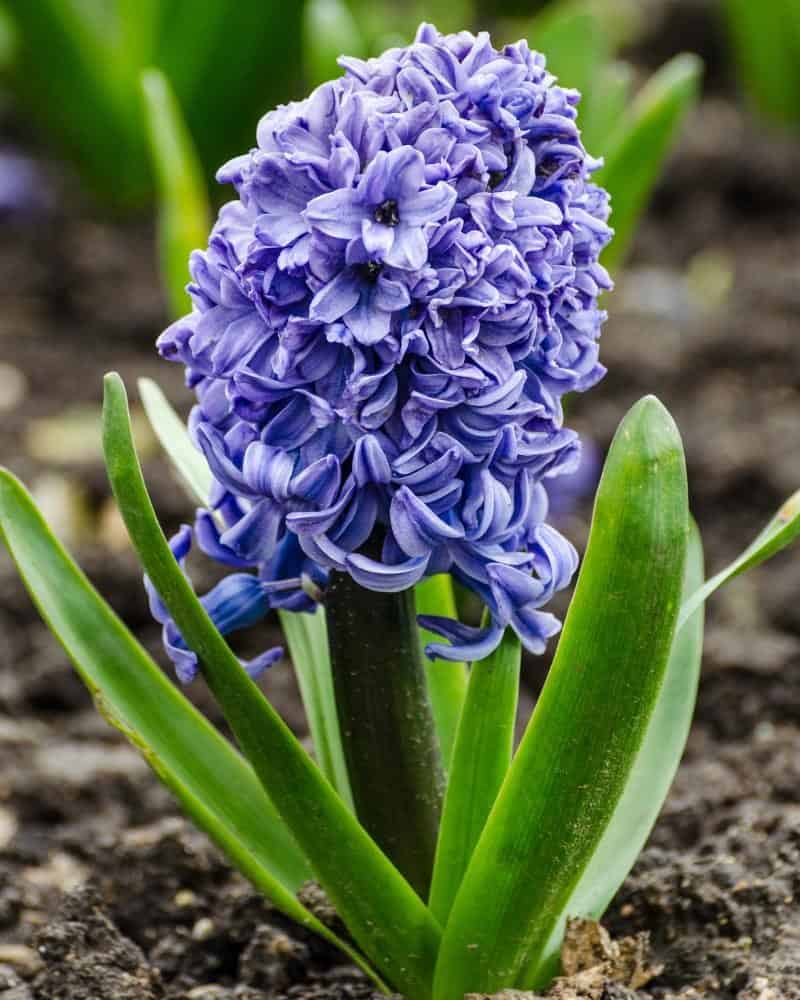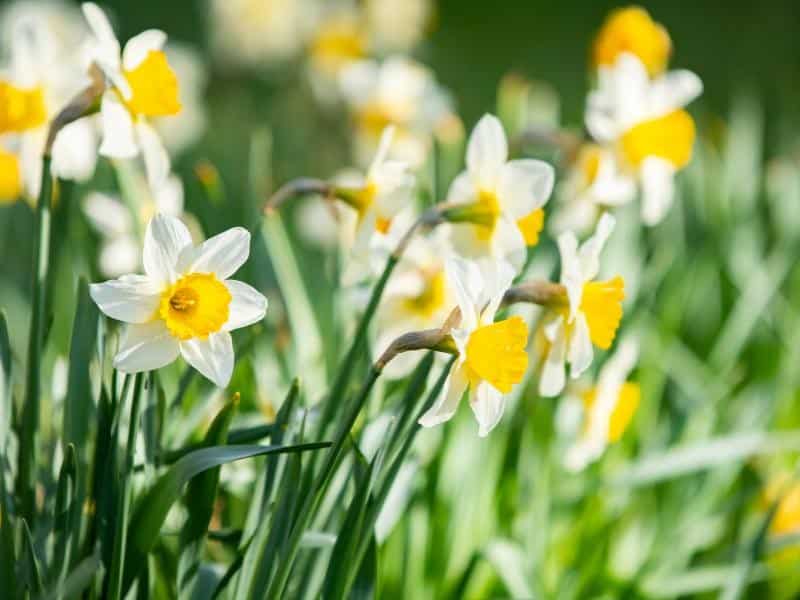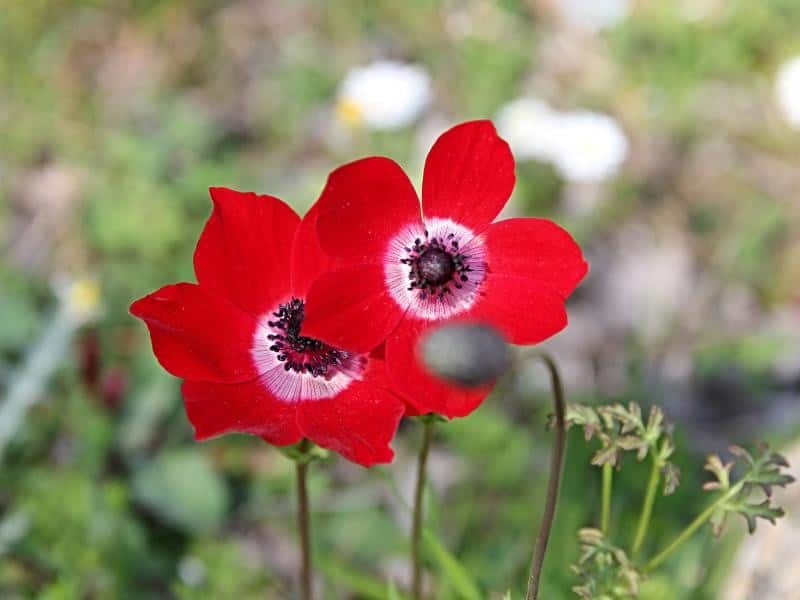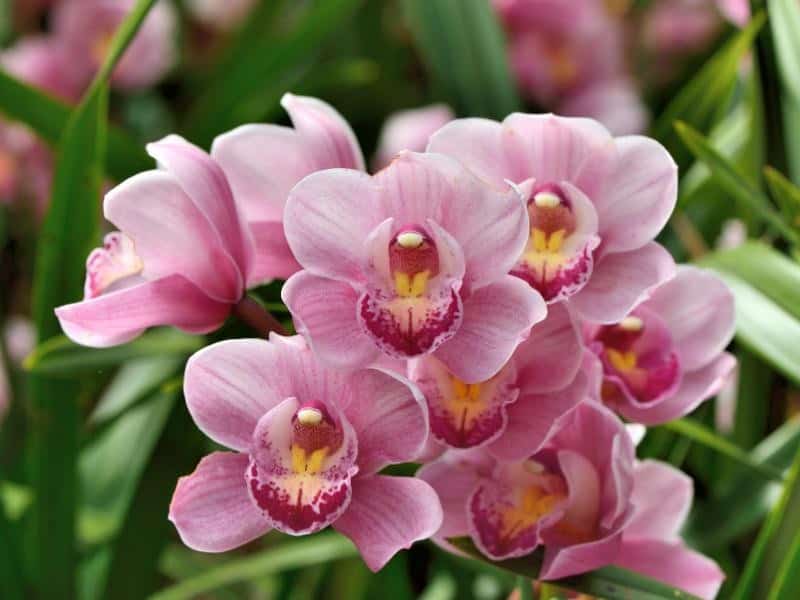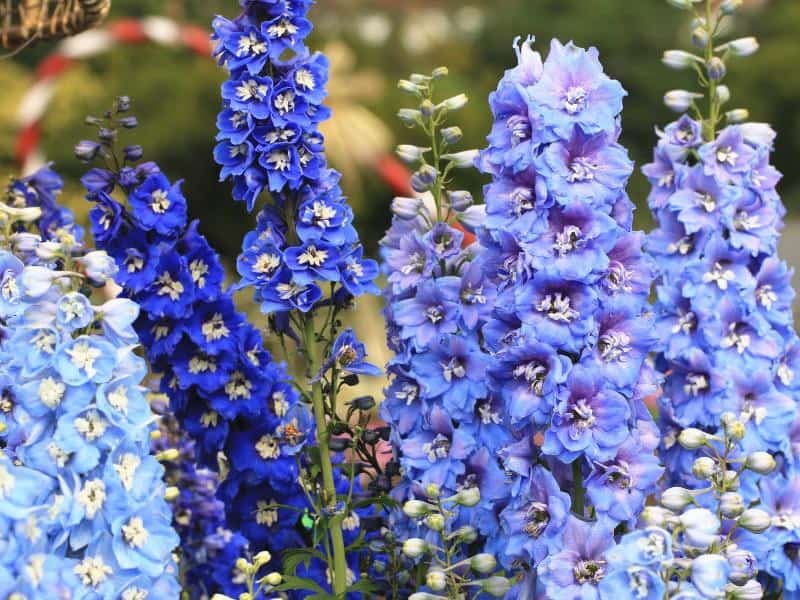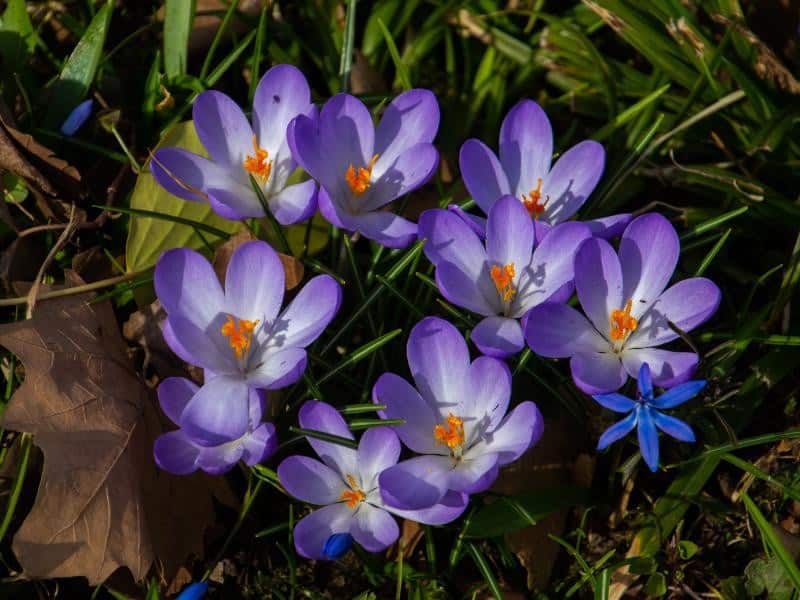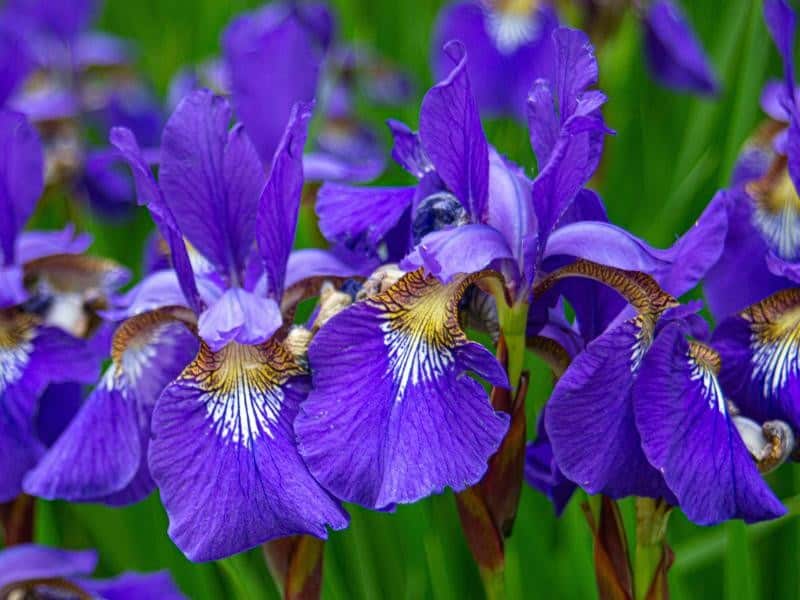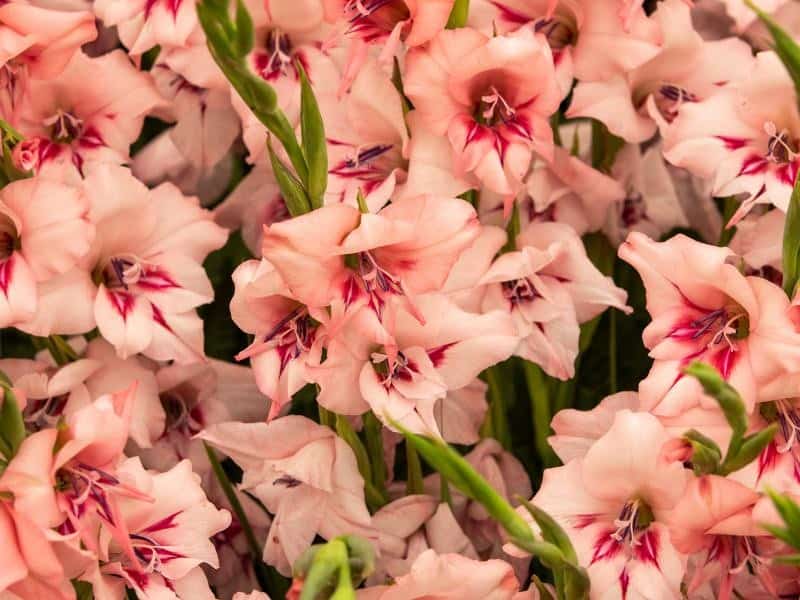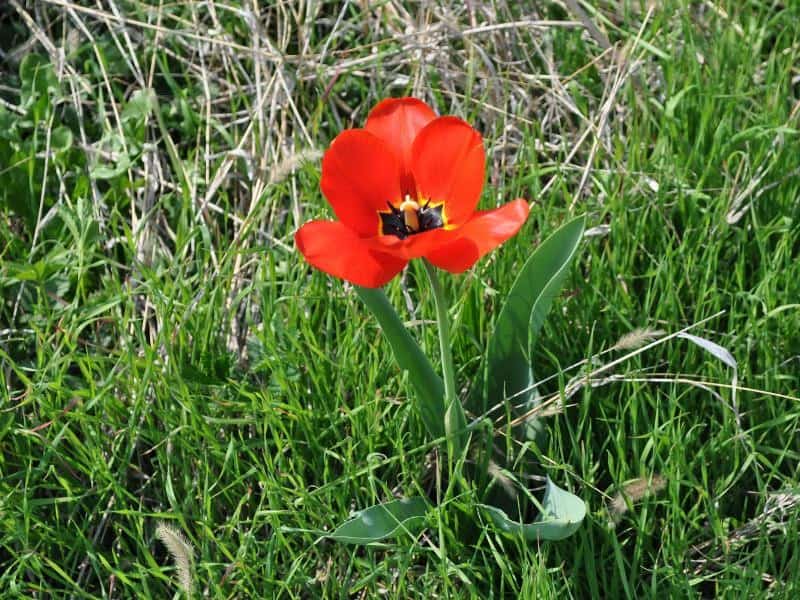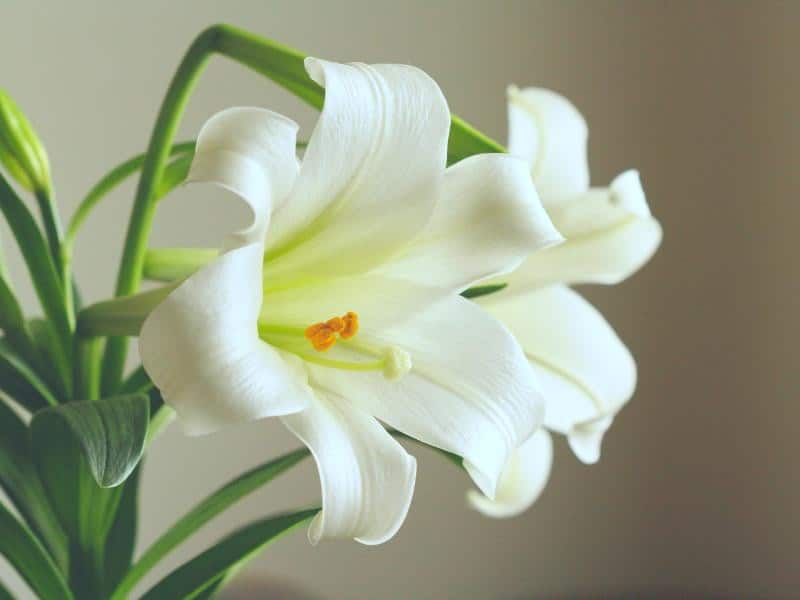Greek mythology is renowned for its captivating characters and intricate storylines, but did you know it also boasts a fascinating array of flowers? From ancient times to modern-day interpretations, these blooms hold significant importance in both mythological and historical contexts. In this article, we’ll delve into the world of Greek flowers, exploring 15 varieties that played a crucial role in myths and everyday life.
We’ll examine their cultural significance, historical relevance, and basic requirements for growth.
15 Greek Flowers Varieties
While not native to Greece, certain flowers gained immense popularity in ancient Greek culture. You may be familiar with the myth surrounding Narcissus, one of many intriguing stories within the vast universe of Greek heroes, anti-heroes, gods, and goddesses. To delve deeper into this captivating world, let’s take a brief journey through time and explore the remarkable flora of that era.
As we do so, the myths and legends will come alive, offering a unique glimpse into the lives and passions of ancient Greeks.
Carnation
While carnations are a popular choice for flower arrangements due to their long-lasting blooms, they also have a rich history and unique characteristics that make them stand out. One of the most interesting aspects of this flower is its slow growth rate, which allows it to thrive in well-draining soil with full sun.
Carnations can grow up to 75 cm tall, and come in a range of colors including scarlet, red, yellow, pink, and white, making them a versatile option for adding a pop of color to any space. Despite their toxicity, carnations have been a symbol of love and fascination for centuries. According to Greek mythology, the origin of carnations can be traced back to two separate stories involving powerful goddesses.
The first story tells the tale of Hera, the goddess of marriage and childbirth, who was jealous of Zeus’s lack of a symbolic flower. As a result, Zeus threw a lightning bolt at Hera’s lily, causing carnations and other flowers to bloom in its place. The second myth surrounding carnations involves Artemis, the hunting goddess, who was so upset with a shepherd for playing the wrong music on his flute that she popped out his eyes.
However, she soon regretted her actions and red carnations began to grow where the shepherd’s eyes had fallen. Whether you’re looking to add some elegance to your home or simply appreciate the beauty of these flowers, carnations are definitely worth learning more about.
Peony
Peonies are a beloved flower globally, not limited to Greece or Italy. These stunning flowers thrive in numerous countries worldwide. Here’s a rundown of their key characteristics:
Scientific name: Peaonia
Native habitat: Asia, Europe, and the western part of North America
Growth rate: Slow and steady
Size: They reach approximately 90 cm (3 ft) in height and width, making them a significant addition to any garden.
Toxicity: Unfortunately, peonies are toxic.
Despite this, their breathtaking red, pink, cream, or white blooms are a sight to behold, transporting your garden to an era reminiscent of Charles Darwin and Charles Dickens, when literature shaped history.
Peonies require optimal growing conditions to flourish. They need full sunlight, well-draining soil, and consistent moisture achieved through regular irrigation (2.5 cm or one inch of water every week). Meeting these demands is crucial for their successful growth stages.
Two ancient Greek myths offer insight into peonies’ origin. According to the first myth, Asclepius, the healing god, and his student Paeon are involved. Hercules inadvertently injured Hades, the god of the Underworld, prompting him to seek Asclepius. Unable to locate him, Hades turned to Paeon, who extracted a healing liquid from peony roots. Enraged by this, Asclepius attempted to kill Paeon, but Zeus intervened and transformed him into a flower.
The second myth revolves around the perils of love and beauty. Apollo was captivated by the charm and elegance of nymph Paeonia, prompting Aphrodite (Hephaestus’ wife) to turn her into a flower when she discovered their relationship. It’s almost ironic that Aphrodite, goddess of love, would transform someone for loving Apollo.
Hyacinth
In many cities around the world, including Athens, you can stumble upon hyacinth flowers while taking a stroll. This popular star-shaped bloom is well-loved across various cultures. With its scientific name being Hyacinthus, this fast-growing flower native to the Eastern Mediterranean stands out for its striking appearance.
Measuring 25 cm tall and 10-15 cm wide, the hyacinth boasts a vibrant cluster of flowers that come in a range of colors from yellow to red, white, blue, pink, lavender, and purple. Despite being toxic, gardeners worldwide can’t resist the charm of these blooms. To bring out the best in your hyacinths, plant them in a spot that receives at least 6 hours of sunlight daily, using well-draining soil and watering only when the topsoil feels dry.
To keep your flowers thriving, add some compost to amend the soil and introduce organic matter. The story of Hyacinthus doesn’t stop at its beauty, though. In Greek mythology, this Spartan prince was a favorite of many, including Apollo, the sun god. His admirers also included Thamyris, Boreas, and Zephyrus, but Hyacinthus ultimately chose Apollo as his lover. Apollo taught him various skills, and they even engaged in a discus-throwing competition.
According to myth, when it was Apollo’s turn, he threw the discus far away, which then bounced off the ground and struck Hyacinthus in the head. Some myths claim that Zephyrus intentionally blew the discus because of jealousy, leading to Hyacinthus’ demise. In a poignant gesture, Apollo created a flower using his lover’s blood, which became known as hyacinth.
Daffodil
Daffodils, also known as Narcissus, have a rich history that’s hard to ignore. But before we dive into their mythological significance, let’s take a look at some key facts about these beautiful flowers. They’re classified under the scientific name Narcissus and are native to North Europe. When it comes to growth rate, daffodils are considered fast growers, with some species reaching sizes of up to 60 cm (2 ft). The toxicity level is also worth noting – they’re toxic in nature.
In terms of appearance, daffodils can be white or yellow with trumpets that come in a range of colors including pink, orange, and yellow. They thrive in full sun exposure and well-draining soil, requiring frequent watering during the growing season but none during their dormant period. With proper care, you’ll soon find yourself surrounded by an abundance of blooms.
The mythological significance of daffodils is perhaps most famous for its story about Narcissus, a mortal in Greek mythology who was so enchanted with his own reflection that he fell into a pond and drowned. According to the legend, this self-absorption led to Nemesis, the goddess of revenge, turning Narcissus’ reflection into a flower – a symbol of stony-heartedness and self-centeredness.
This mythological tale has been passed down through the centuries, making daffodils an intriguing part of our collective cultural heritage.
Red Anemone
In the realm of ancient Greek mythology and stunning flowers, the red anemone holds a special place in our hearts. But before we dive into its captivating story, let’s take a glimpse at its fundamental characteristics. The scientific name for this enchanting bloom is Anemone, native to all subtropical and temperate regions – with the exception of Australia and Antarctica.
Its growth rate is slow to moderate, while its size can vary greatly depending on the species, ranging from 15 cm (6 in) to 120 cm (4 ft) tall and 60-90 cm (2-3 ft) wide. Despite being listed as a toxic plant, our affection for these flowers transcends any potential harm. To keep them thriving, they require partial shade, so it’s essential not to expose them to excessive sunlight. Plant the red anemone in well-draining and fertile soil, and ensure it receives adequate hydration by providing 2.
5 cm (an inch) of water weekly – unless rainfall takes care of that need. The name ‘Anemone’ itself is derived from the Greek word for windflower, a plant closely tied to the myth of Adonis’ tragic demise. Persephone, the queen of the Underworld, and Aphrodite, the goddess of love, both fell deeply in love with Adonis. However, his fate was sealed when a wild boar attacked him, leaving him crying out in agony.
Aphrodite heard his pleas for help, but by the time she found him, he was on the brink of death. According to myth, red anemones sprouted from the ground where Adonis’ blood stained the earth. Another account suggests that white anemones were already present in the area, but after Adonis’ blood droplets touched their delicate petals, they transformed into the vibrant red we know today.
Orchid
Orchids have captivated humans for centuries with their breathtaking beauty and air of elegance. But did you know that these charming flowers hold a rich history in Greek mythology? Before we delve into the fascinating tales surrounding orchids, let’s take a brief look at some basic facts about these stunning blooms. Orchidaceae is the scientific name for this family of plants, which are native to the tropics of Asia and Australia.
Orchids grow at a slow rate and can reach heights of 20-90 cm (8 in – 3 ft) with a width of 30 cm (1 ft). Fortunately, these flowers are non-toxic, making them safe for human consumption. Orchids come in an array of vibrant colors, including white, pink, purple, green, blue, yellow, orange, and red. These stunning blooms will adorn your space from spring to fall, but it’s essential to provide the right conditions for optimal growth.
Water your orchids twice weekly during warm weather and once a week during winter. Plant them in an orchid mix, which should be changed annually to ensure proper nutrition. When it comes to lighting, avoid direct sunlight as orchids are susceptible to sunburn. Proper care is crucial, as improper fertilization, temperature, lighting, or watering can lead to the demise of these delicate flowers. Despite their reputation for being fragile, orchids have a significant role in Greek mythology.
According to legend, Orchis, a demigod, attempted to rape a priestess during the Dionysia celebration, which honors pleasure, wine, and fertility. As punishment, wild beasts mutilated Orchis, and orchids began growing where his dismembered body fell. The two tubers on an orchid plant are said to symbolize Orchis’ sin, while the luxurious flower heads represent his beauty.
Interestingly, ancient Greeks believed that the tubers possessed aphrodisiac properties that could determine the sex of an unborn child (the mother would eat small tubers for a girl or the father would eat large ones for a boy).
Larkspur
The Larkspur, a beautiful blue flower often mistaken for creeping bougainvillea in the Greek islands, holds its own unique charm. But beyond its aesthetic appeal, this plant has some fascinating facts to share. Scientifically known as Delphinium, the Larkspur is native to the Northern Hemisphere and boasts a moderate growth rate, reaching heights of 90-120 cm (3-4 ft) with a spread of 30 cm (1 ft).
While it may be toxic to some, its stunning indigo, purple, and pink blooms are certainly worth the risk. For optimal growing conditions, provide Larkspur with full sun but offer shade during extreme heat. Plant it in loose, light soil that drains well and water once or twice a week, adjusting the amount based on rainfall. A 2.5 cm (1 in) deep irrigation is a good starting point. What’s more intriguing about the Larkspur is its dark mythological significance.
According to legend, Achilles’ armor was granted to Ulysses after the Battle of Troy, leaving Ajax consumed by rage and ultimately leading to his tragic demise by throwing himself onto his sword. As his blood spilled on the ground, delicate Larkspur flowers began sprouting, forever linking this flower with a somber chapter in history.
Saffron Crocus
Saffron crocuses, with their striking lavender crowns, embody universal beauty. Their myths revolve around faithful love, making them an intriguing subject to explore. Here’s what you need to know about this enchanting plant: Its scientific name is Crocus sativus, and it originates from the Middle East and Greece. A fast-growing species, crocuses reach a height of 10 cm (4 in) tall. However, they’re toxic and require careful handling.
To thrive, these plants need to be planted in well-draining soil like sandy loam and fertilized annually. They should only receive water if there hasn’t been rainfall for 3-5 days during their growing season, and they enjoy full sun conditions. Watering requirements aside, the myth surrounding Crocus is a poignant tale of love. According to legend, Hermes killed Crocus with his discus, transforming him into a flower. The three droplets of his blood became the crocus’s distinctive stains.
Another myth tells the story of a nymph named Smilax and her mortal lover, Crocus. Despite their love, the gods disapproved, turning Smilax into bindweed and Crocus into a flower. These captivating myths highlight the enduring power of love in ancient cultures.
Iris
In Greek mythology, Iris is a beloved flower with a charming story that’s free from gory or bloody undertones. Before diving into the mythological aspects, let’s cover some fundamental facts about this lovely bloom. The scientific name for iris is simply ‘Iris’, and it’s native to Europe, Western Asia, and North Africa. As for its growth rate, irises are considered moderate-paced growers. They can reach approximately 90 cm (3 ft) in height.
One important note: irises are toxic, so be cautious when handling them. What makes irises truly special is the array of colors they come in – blue, yellow, orange, red, pink, white, and even black! This means you can choose the perfect hue to adorn your garden with. To thrive, plant your irises in well-draining soil and provide regular irrigation (at least once a week). Make sure the topsoil is dry before watering again.
In terms of sunlight, irises prefer about six hours of direct sunlight daily, but they’ll also appreciate some shade to protect them from intense heat. Now that we’ve covered the basics, let’s explore the fascinating mythological connection between Iris and the rainbow. In Greek mythology, Iris was the goddess of the rainbow, acting as a messenger for Hera and Zeus when they wanted to communicate with mortals. According to legend, she used the rainbow as a bridge between the heavens and Earth.
Some myths also refer to the rainbow as her cloak. The Greeks incorporated this myth into their cultural practices, and it’s said that people would plant irises on graves to entice the rainbow goddess to help the souls of loved ones cross over to the afterlife.
Gladiolus
Gladiolus, a flower steeped in myth and mystery, offers a fascinating contrast to the romantic tales often associated with its companion plant, hyacinths. While gladiolus has a reputation for being slow-growing and toxic, its rich history is rooted in the Greek myth of Demeter, goddess of harvest, and Erysichthon, a godless man consumed by greed.
According to legend, Erysichthon’s brutal cutting down of sacred trees in Thessaly earned him the wrath of Demeter, who transformed the bloodied earth into small, sword-shaped gladiolus flowers. But this was not the end of the tale: Demeter’s vengeance did not stop there, as she afflicted Erysichthon with famine, forcing him to sell his daughter for sustenance. The tragic consequences of his actions ultimately led to his own demise, devouring himself in desperation.
Despite its toxic nature and slow growth rate, gladiolus remains a stunning addition to any garden, available in an array of colors including white, red, pink, yellow, and green. By planting them in well-draining soil with full sun exposure, gardeners can enjoy the beauty and symbolism of these striking flowers.
Rose
Roses are another popular flower that can be found at various events or even sold on streets. It’s lovely to have a bouquet of roses around, but it’s crucial to know how to extend their shelf life and make them last without water. To do this, you need only change the water regularly, feed them with flower food or sugar, and avoid exposing them to too much sunlight. Roses are known scientifically as Rosa and originate from the northwest regions of Africa, Europe, North America, and Asia.
They have a fast growth rate, with the smallest species growing up to 15-30 cm (6-12 in) and the largest reaching up to 6 m (20 ft). Fortunately, they’re non-toxic. To care for roses, plant them in well-draining soil amended with humus and nutrients. Provide them with 6 hours of sunlight daily, preferably during morning hours, and give them 15-19 liters (4-5 gallons) of water weekly. Roses have a rich history in Greek mythology, with two narratives surrounding the flower.
The first story involves Aphrodite and her lover Adonis, who was mortally wounded by a wild boar. When Aphrodite found him, she shed tears that mixed with his blood, creating a red rose bush from the soil. The second story tells of Chloris, the goddess of flowers, who would release roses whenever she spoke. Another myth claims that Chloris transformed a beautiful nymph into a flower after being amazed by her beauty.
Apollo allowed the sun to shine on the flower, Zephyrus blew wind to clear the sky, Dionysus provided nectar for the rose’s sweet fragrance, and Aphrodite embellished the flower with beauty.
Bay Laurel
In ancient Greek mythology, the laurel holds a special place in the story of Daphne, a Niad nymph, and Apollo, the sun god. However, before delving into its mythological significance, let’s explore some fascinating facts about this plant. The bay laurel (Laurus nobilis) is native to the Mediterranean region, where it grows slowly and can reach up to 6 meters in height.
Its leaves are the main attraction for most growers, but the pale yellow blooms that appear in late spring or early summer are a lovely bonus. This plant is surprisingly easy-going and can thrive in a variety of soils as long as they drain well. In full sun, the bay laurel flourishes, but it also appreciates some shade when temperatures soar. One thing to keep in mind is that it doesn’t perform well in wet soil, so be sure to irrigate only when the top 5 centimeters are dry.
When it comes to its mythological significance, the story of Daphne and Apollo is a timeless classic. According to legend, Eros shot both Daphne and Apollo with arrows – one that made her loathe romantic gestures and another that made him fall deeply in love with her. As Apollo’s pursuit of Daphne continued, she eventually asked her father, the river god Peneus, to intervene. In response, Peneus transformed his daughter into a laurel tree.
Apollo treasured this new form of Daphne and wore a laurel crown as a symbol of his love. The story also suggests that he granted the tree immortality by making it evergreen. Today, the laurel remains an enduring symbol of victory, honor, and accomplishment.
Poppy
Papaver, also known as Poppies, has a rich mythological history surrounding the Greek goddess of harvest, Demeter. Before delving into its mythological significance, let’s start with some general information about this plant. Papaver is a fast-growing flower that thrives in well-draining substrates and full sun, typically reaching heights of 30-35 cm (1-1.2 ft). Its native habitat spans North Africa and Eurasia. Interestingly, the toxicity of Poppies makes them cautionary to handle.
This flowering beauty blooms from mid-to-late spring, showcasing a range of colors including red, purple, white, and pink, contrary to the commonly seen red varieties in pictures. With easy care requirements, poppies can be easily cultivated by providing at least 6-8 hours of direct sunlight daily, occasional irrigation for dry areas, and well-draining soil. The flower’s association with sleep dates back to ancient times, linking it to Greek gods Thanatos, Morpheus, and Hypnos.
However, its mythological significance is more deeply rooted in Demeter’s story. According to legend, Poppies were created to help Demeter fall asleep after the abduction of her daughter Persephone. As the myth goes, poppies would sprout from beneath Demeter’s feet whenever she took a step.
Lily
Lilies may be most closely associated with Greece, but they also hold a special place in Spanish culture. Before we delve into their mythological significance, let’s start by exploring some basic facts about these beautiful flowers.
Scientifically known as Lilium, lilies are native to temperate regions of the Northern Hemisphere. They grow at a moderate pace and can reach heights of 60-180 cm (2-6 ft), depending on the specific variety.
However, it’s worth noting that lilies contain toxic compounds, so care must be taken when handling them.
As you’d expect from their reputation as a symbol of purity and innocence, lilies come in a range of colors, blooming from summer to fall. To get the most out of your lily plants, make sure they’re planted in well-draining soil with plenty of nutrients, and provide them with at least six hours of sunlight daily.
But lilies’ connection to Greek mythology is perhaps their most enduring legacy. According to legend, Zeus’ infidelity led to the birth of Hercules, who was then nursed by Hera after she’d fallen asleep. As the myth goes, Hera woke up and shoved the baby away with such force that milk continued to flow, forming the Milky Way as it spilled onto the earth. The drops that landed on Earth transformed into lilies, a symbol of both purity and the power of divine intervention.
Sunflower
While many people are familiar with sunflowers’ association with warmth and sunshine, few know about their fascinating connection to Greek mythology. The scientific name for sunflowers is Helianthus annuus, and they are native to the southern and central United States, as well as Mexico. These fast-growing flowers can reach impressive heights of up to 4.5 meters (15 feet), making them a great addition to any garden.
Sunflowers are also non-toxic, meaning they’re safe for children and pets to be around. One of the most interesting aspects of sunflowers is their ability to thrive in a variety of conditions. They can be grown with companion plants like lavender, basil, cucumbers, and tomatoes, making them perfect for small spaces. To grow sunflowers successfully, simply provide them with plenty of sunlight, well-draining soil rich in organic matter, and irrigate them once a week if rainfall is limited.
The Greek myth surrounding sunflowers is a powerful tale of love, betrayal, and transformation. According to the myth, Helios, the god of the sun, fell in love with Leucothoe, a mortal Persian princess, rather than Clytie, a water nymph who was deeply in love with him. When Clytie discovered their relationship, she reported it to Leucothoe’s father, King Orchamus, leading to tragic consequences for all involved.
As the myth goes, Clytie became consumed by jealousy and refused food or water, instead gazing up at the sun as Helios pulled his chariot across the sky. For nine days, she sat naked on the ground, eventually transforming into a sunflower that forever follows the sun’s path, still demonstrating her enduring love for Helios.
Commonly Asked Questions
While we’ve already delved into the fascinating world of Greek flowers and their rich mythology, it’s only natural to continue exploring this topic further. Here, we’ll tackle the most frequently asked questions about these beautiful blooms, providing insight into what makes them so unique and captivating.
Which flower represents Greece?
Laurel, often symbolic of Greece, has a rich history tied to ancient mythology. According to legend, Apollo, the sun god, crafted a wreath from laurel leaves and wore it as a token of his affection for Daphne, the nymph he loved. This iconic crown was not only a symbol of their love but also a prized award presented to winners at the prestigious Pythian Games, held in honor of Apollo.
Which popular flower can I gift on Mother’s Day in Greece?
While it’s common to associate chrysanthemums with Mother’s Day celebrations in Greece, this tradition is actually a departure from the country’s cultural heritage. In fact, the Greeks never officially celebrated Mother’s Day at all. Instead, they honored Rhea, the mythological mother of numerous gods and goddesses. Despite this, you can still opt for other flowers like carnations, roses, or popular varieties to show your appreciation. Any choice will likely be well-received.
Final Remarks
In our exploration of Greek flowers and their associated myths, we’ve uncovered a rich tapestry of stories that offer valuable insights into the cultural significance of these blooms. From symbols of protection and honor to expressions of grief and love, each flower’s mythological narrative provides a unique window into the worldviews and values of ancient Greece.
In addition to delving into these fascinating tales, we’ve also shared practical advice on how to care for these flowers, ensuring that they thrive in your garden with minimal fuss. One of the greatest charms of these flowers is their unassuming nature – they’re not demanding or high-maintenance, allowing you to effortlessly create a beautiful and mystifying garden. As you set out to cultivate your own mythological oasis, we wish you all the best on your gardening journey.

